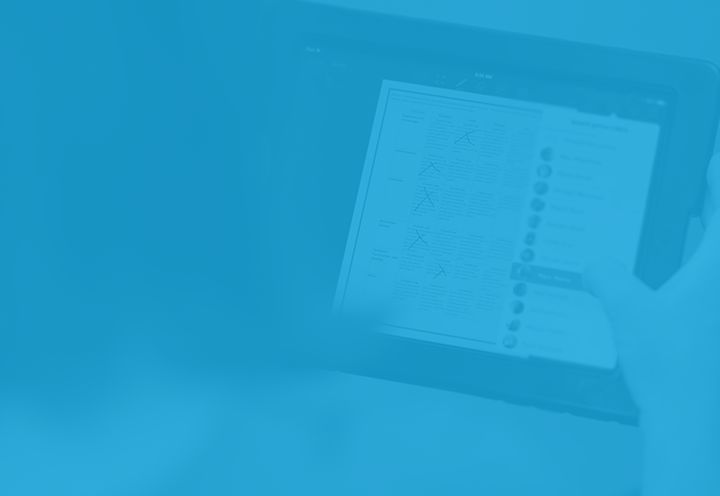Employing a Universal Design for Learning cannot be successful without finding innovative solutions to teach every learning type and ability. See how teachers in the SSRCE have worked tirelessly to integrate technology into the classroom to personalize education for all learners.
1:1 Implementation With Multifaceted Support
Since 2011, the South Shore Regional Centre for Education (SSRCE) in Nova Scotia, Canada, has implemented technology into its 24 school sites via shared iPad carts. Teachers and students adapted quickly to the new devices, and soon the district realized the benefit of expanding to a 1:1 technology program for its 6,300+ students. In 2013, leaders in the SSRCE developed the Technology Engagement Learning Project (TELP), a 1:1 iPad implementation strategy utilizing the Universal Design for Learning (UDL), and implemented it in selected classrooms throughout the district. The goal of the program is to empower students with powerful digital devices that allow them to express knowledge of a subject through a variety of new media, thus creating a flexible learning environment that promotes creativity for all types of learners.
The TELP program has grown to 14 school sites in grades 4-12, two of which are fully 1:1. As a smaller, rural district, the SSRCE looked to the community and families to help acquire devices; partnerships with families were created by including a bring-your-own-device (BYOD) component. To provide equity for those families that could not afford to purchase their own iPad, participating schools dismantled their shared iPad carts and distributed devices to those students.
TELP is not a district-wide mandate, which gives schools the flexibility to implement the program at their own pace. For example, one school may have all grades in TELP, while another may have pockets of teachers in the program. While the lack of uniformity in 1:1 device use has created some challenges, the iPads are such a flexible tool that teachers have been able to overcome technology hurdles with relative ease.
Andrea Conrad, Learning Disability Facilitator and a technology integration champion at SSRCE, explains that, “As a non-urban district, we must be very mindful of social factors that surround our students when implementing TELP, and take into account that many students may not have the means to access the internet when they are not in school. The iPad allows teachers to find viable workarounds for these situations, such as downloading documents to a student’s device during class so he or she may access the document at home and not fall behind in their classwork.”
Each school site is unique in its implementation of TELP, but one key factor has been vital to the success of the program at each site—teacher support. Teachers have been instrumental in TELP’s implementation through promoting the benefits of going 1:1 and training colleagues on how to use their iPads during instruction. As it has become increasingly difficult to find time outside school hours for professional development training (beyond the five prescribed district training days), teachers with tech-integrated classes have volunteered to conduct their own instructional sessions with individual or small groups of teachers to familiarize them with their devices.
“Without the tireless efforts of our teachers, we wouldn’t see the success of the TELP program that we see today,” says Jim Dexter, Coordinator of Technology Integration and Data Management. “Many of our teachers have become champions for technology in the classroom, and have been instrumental in creating momentum in the program’s growth throughout the district.”
“Simpler Is Better”
Shortly after the implementation of the TELP program, Erin Dunn-Keefe, Literacy Coach and technology integration champion, was introduced to Showbie as a workflow solution. After seeing how Showbie was able to solve her own workflow issues with her students by allowing her to distribute and collect work, as well as provide highly personalized feedback to her students, Erin began to spread the word to her colleagues, including Andrea.
“Before Showbie,” explains Andrea, “teachers struggled to share work with students using labor-intensive, clunky apps. Showbie provided a consistent, easy-to-use platform for teachers and students to create and share documents, which eased the transition to technology in the classroom for many of our teachers.”
After running successful pilot tests in a few classrooms, Jim’s tech team and core group of technology integration champion teachers began implementing Showbie and provided training on its use across the SSRCE. “Showbie requires such little training, and the teachers in the TELP program were very receptive to using the app immediately,” says Jim. “By the second year of the program, Showbie’s use doubled, and more than 50% of our teachers in SSRCE use the app today.”
Showbie’s functionality and compatibility with other apps is another huge draw for teachers in the district. Barbara Welsford, Assistive Technology Specialist at SSRCE, has experienced Showbie’s benefits in the classroom and has observed that “with our UDL-based curricula, students often complete assignments and activities in various formats. The ease of submitting these projects through Showbie is second to none, and has literally changed the game for technology use in the classroom.”
Regarding the inherent simplicity of the app, Barbara further explains that “one of our mantras in the AT Centre is ‘simpler is better.’ Showbie provides this simplicity for content management in the classroom, and teachers are experiencing a significant increase in work submission as a result.” To prove that Showbie had a positive impact in increasing completed work in her classroom, Erin Dunn-Keefe compared her missing assignment rates before and after Showbie’s implementation. When comparing the data in her grade 10 English classroom, Erin found that her missing assignment rate decreased from 5.21% to just 0.63%.
“Showbie allows students to submit work from thousands of apps in one location,” explains Erin. “Students are no longer shuffling through several different books for information or various folders for their assignments, making it easier for them to be accountable for their hard work. Both teachers and students appreciate Showbie’s ability to house all pertinent learning information for each student in one easily accessible digital portfolio.”
Showbie for Every Learner
Showbie has been essential to SSRCE’s TELP implementation across its school sites. The flexibility in its platform and compatibility with a world of other educational applications allows Showbie to be beneficial to all types of learners at SSRCE, from those with learning disabilities to students preparing for post-secondary education.
As a Literacy Coach, Erin’s goal is to find new and innovative ways to improve literacy skills for students at SSRCE.
“Because I am able to share multiple representations of a lesson through video, text, and audio,” says Erin, “all of my learners can be engaged in the lesson, which gives students independence as everything they need is provided in Showbie.”
Some specific ways Erin uses Showbie to enhance literacy include recording students’ reading so she can analyze reading together with the student and using annotations to provide “meaningful, personalized feedback,” as well as using Showbie in congruence with other apps to build vocabulary skills. As noted earlier in her grade 10 English classroom study, Erin found a significant increase in assignment completion using Showbie, which also holds true for her students with executive functioning difficulties who often lose track of paper assignments and struggle with organizational skills.
For those students experiencing learning difficulties, Andrea Conrad, as Learning Disability Facilitator, has also seen a significant improvement in her students’ achievements. “Showbie has leveled the playing field for my students in the classroom,” says Andrea. “Now I can customize my lesson plans for each student’s needs, and focus on the tools they need to succeed in class regardless of the learning type I am addressing.” Andrea can utilize voice notes, include video links, or simply write notes on a document to provide highly personalized feedback and promote interactive learning in the classroom. Providing a balanced education for students with learning disabilities is of utmost importance. Showbie allows students to tackle assignments in ways that augment their individual learning styles, while enhancing creativity and motivation overall.
While Showbie can enhance learning at the most basic level, it can also help prepare students for the future. Jane Berrigan, Lead Options and Opportunities (O2) Teacher, provides career-based educational classes to students in grades 10-12, to explore various careers of interest and also prepare them for postsecondary education. Outside the classroom, Jane is also responsible for pairing 70 of her students with employers throughout the community in a co-operative education program designed to give students 100+ hours of real-world experience in various careers. With each of these students comes a mountain of paperwork, including time logs, employer site visit logs, employer/student assessments, and letters of recommendation.
“I was forever chasing papers and struggling to keep 70 student folders up to date and organized,” says Jane. “Now I can have employers log their assessments directly into Showbie, and students can input and view their progress in the program at any time. Any paperwork that is part of this program is now in one accessible location, which really helps students stay accountable for their own work.”
Students are so excited about being able to access their portfolios to see how they’ve progressed in a subject. “I’ve even heard of students taking their iPads into college interviews so they can highlight their school accomplishments through Showbie portfolios,” says Jane.
Jane can also recall an instance in which using Showbie with the iPad helped a student with a severe learning disability in reading “bloom” once he got his hands on the technology. In a relatively short period of time, the student gained proficiency in reading, primarily through using Showbie’s voice recording tool in combination with various reading apps. With the success he gained in school, this student was able to secure a paid internship with a local engineer over the summer. Jane sums up Showbie’s impact in her classroom by saying that “Showbie moves technology past simply scanning and sending documents. With its compatibility with other apps and capability to feature student achievements in one location, this app is truly invaluable for preparing my students for their future.”
Finally, though Jim Dexter does not have daily access to students in the classroom while he is supporting and advocating for the TELP program throughout the district, he still receives constant input from the teachers in the program. Jim was recently approached by a grade 2-3 teacher who was looking for a better solution where it was almost immidnet that a student would be removed from her class due to significant behavioral challenges. “Rather than completely omit this student from her classroom, the teacher approached me about giving the student an iPad and using Showbie to keep him engaged in the class, even if he couldn’t physically be present,” explains Jim. This teacher was not involved in the TELP program, but after consulting with other teachers involved in the program, she knew this was the right solution for her student.
In some cases, a uniform 1:1 rollout is not necessary for a successful technology program. Allowing teachers and students to organically find what works best for them in their own classrooms is the key not only to getting buy-in for a new initiative, but allowing the users the freedom to discover innovative uses for the tools provided to them. Through effective shared communication and teacher dedication, students of all learning abilities in SSRCE are preparing for a bright future using 21st-century technology.




